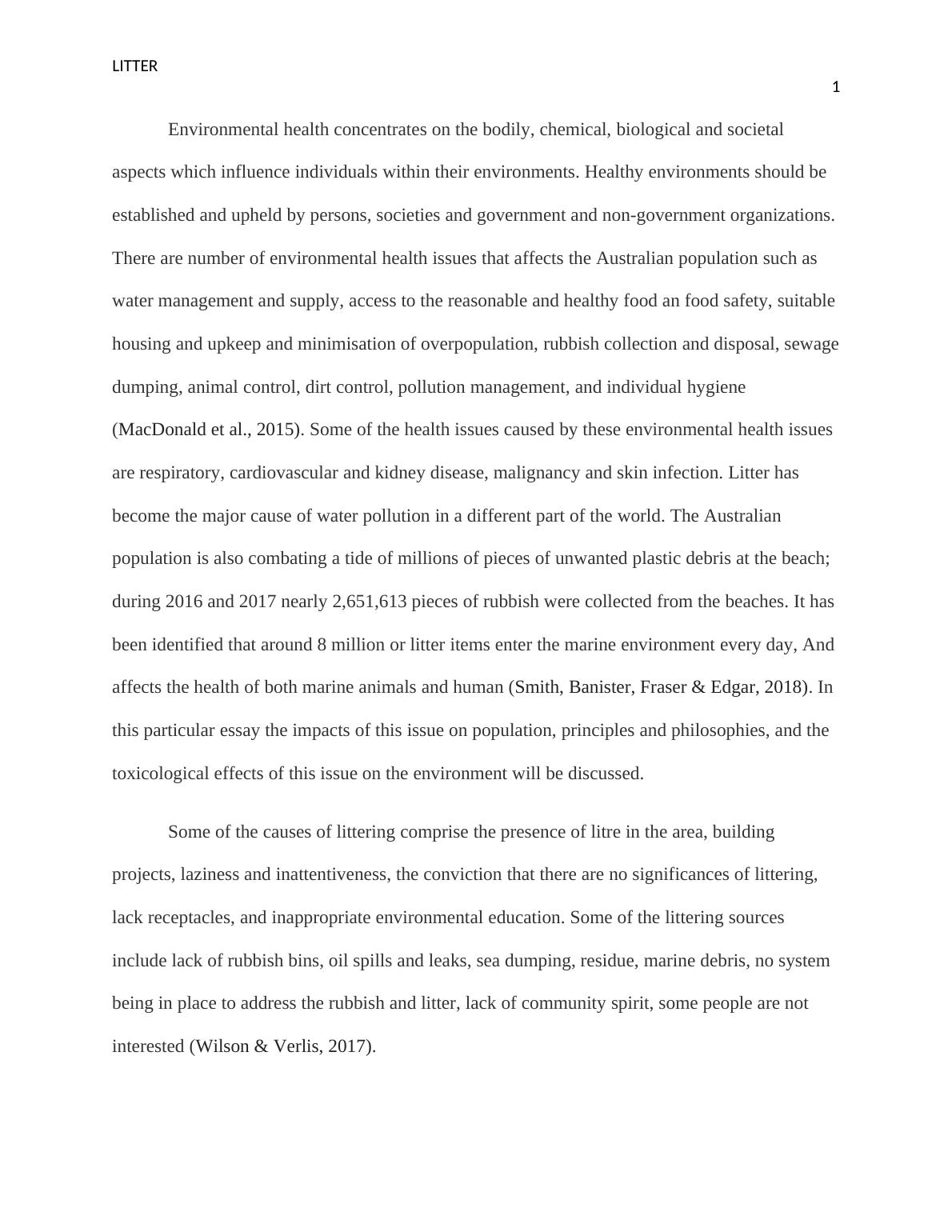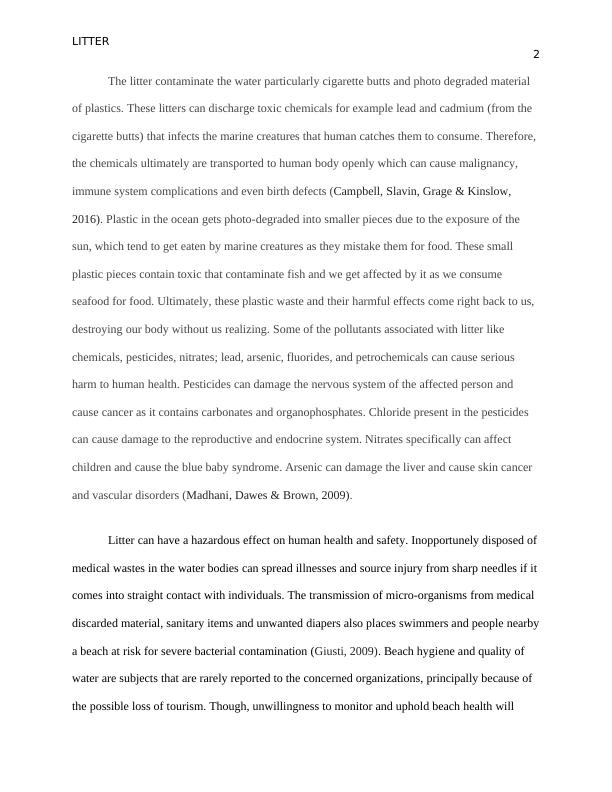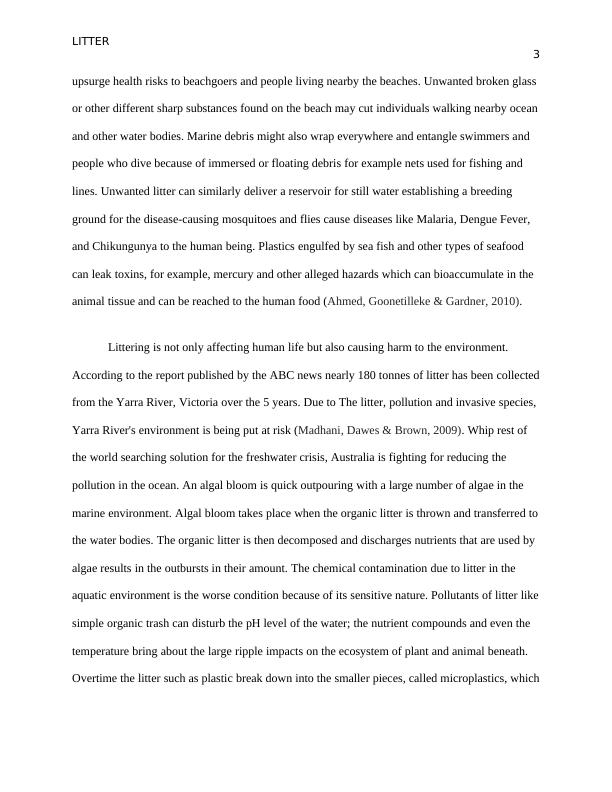Litter: Causes, Impacts, and Solutions
Added on 2022-12-28
11 Pages2795 Words22 Views
Running Head: LITTER
0
Litter
Essay
student
8/31/2019
0
Litter
Essay
student
8/31/2019

LITTER
1
Environmental health concentrates on the bodily, chemical, biological and societal
aspects which influence individuals within their environments. Healthy environments should be
established and upheld by persons, societies and government and non-government organizations.
There are number of environmental health issues that affects the Australian population such as
water management and supply, access to the reasonable and healthy food an food safety, suitable
housing and upkeep and minimisation of overpopulation, rubbish collection and disposal, sewage
dumping, animal control, dirt control, pollution management, and individual hygiene
(MacDonald et al., 2015). Some of the health issues caused by these environmental health issues
are respiratory, cardiovascular and kidney disease, malignancy and skin infection. Litter has
become the major cause of water pollution in a different part of the world. The Australian
population is also combating a tide of millions of pieces of unwanted plastic debris at the beach;
during 2016 and 2017 nearly 2,651,613 pieces of rubbish were collected from the beaches. It has
been identified that around 8 million or litter items enter the marine environment every day, And
affects the health of both marine animals and human (Smith, Banister, Fraser & Edgar, 2018). In
this particular essay the impacts of this issue on population, principles and philosophies, and the
toxicological effects of this issue on the environment will be discussed.
Some of the causes of littering comprise the presence of litre in the area, building
projects, laziness and inattentiveness, the conviction that there are no significances of littering,
lack receptacles, and inappropriate environmental education. Some of the littering sources
include lack of rubbish bins, oil spills and leaks, sea dumping, residue, marine debris, no system
being in place to address the rubbish and litter, lack of community spirit, some people are not
interested (Wilson & Verlis, 2017).
1
Environmental health concentrates on the bodily, chemical, biological and societal
aspects which influence individuals within their environments. Healthy environments should be
established and upheld by persons, societies and government and non-government organizations.
There are number of environmental health issues that affects the Australian population such as
water management and supply, access to the reasonable and healthy food an food safety, suitable
housing and upkeep and minimisation of overpopulation, rubbish collection and disposal, sewage
dumping, animal control, dirt control, pollution management, and individual hygiene
(MacDonald et al., 2015). Some of the health issues caused by these environmental health issues
are respiratory, cardiovascular and kidney disease, malignancy and skin infection. Litter has
become the major cause of water pollution in a different part of the world. The Australian
population is also combating a tide of millions of pieces of unwanted plastic debris at the beach;
during 2016 and 2017 nearly 2,651,613 pieces of rubbish were collected from the beaches. It has
been identified that around 8 million or litter items enter the marine environment every day, And
affects the health of both marine animals and human (Smith, Banister, Fraser & Edgar, 2018). In
this particular essay the impacts of this issue on population, principles and philosophies, and the
toxicological effects of this issue on the environment will be discussed.
Some of the causes of littering comprise the presence of litre in the area, building
projects, laziness and inattentiveness, the conviction that there are no significances of littering,
lack receptacles, and inappropriate environmental education. Some of the littering sources
include lack of rubbish bins, oil spills and leaks, sea dumping, residue, marine debris, no system
being in place to address the rubbish and litter, lack of community spirit, some people are not
interested (Wilson & Verlis, 2017).

LITTER
2
The litter contaminate the water particularly cigarette butts and photo degraded material
of plastics. These litters can discharge toxic chemicals for example lead and cadmium (from the
cigarette butts) that infects the marine creatures that human catches them to consume. Therefore,
the chemicals ultimately are transported to human body openly which can cause malignancy,
immune system complications and even birth defects (Campbell, Slavin, Grage & Kinslow,
2016). Plastic in the ocean gets photo-degraded into smaller pieces due to the exposure of the
sun, which tend to get eaten by marine creatures as they mistake them for food. These small
plastic pieces contain toxic that contaminate fish and we get affected by it as we consume
seafood for food. Ultimately, these plastic waste and their harmful effects come right back to us,
destroying our body without us realizing. Some of the pollutants associated with litter like
chemicals, pesticides, nitrates; lead, arsenic, fluorides, and petrochemicals can cause serious
harm to human health. Pesticides can damage the nervous system of the affected person and
cause cancer as it contains carbonates and organophosphates. Chloride present in the pesticides
can cause damage to the reproductive and endocrine system. Nitrates specifically can affect
children and cause the blue baby syndrome. Arsenic can damage the liver and cause skin cancer
and vascular disorders (Madhani, Dawes & Brown, 2009).
Litter can have a hazardous effect on human health and safety. Inopportunely disposed of
medical wastes in the water bodies can spread illnesses and source injury from sharp needles if it
comes into straight contact with individuals. The transmission of micro-organisms from medical
discarded material, sanitary items and unwanted diapers also places swimmers and people nearby
a beach at risk for severe bacterial contamination (Giusti, 2009). Beach hygiene and quality of
water are subjects that are rarely reported to the concerned organizations, principally because of
the possible loss of tourism. Though, unwillingness to monitor and uphold beach health will
2
The litter contaminate the water particularly cigarette butts and photo degraded material
of plastics. These litters can discharge toxic chemicals for example lead and cadmium (from the
cigarette butts) that infects the marine creatures that human catches them to consume. Therefore,
the chemicals ultimately are transported to human body openly which can cause malignancy,
immune system complications and even birth defects (Campbell, Slavin, Grage & Kinslow,
2016). Plastic in the ocean gets photo-degraded into smaller pieces due to the exposure of the
sun, which tend to get eaten by marine creatures as they mistake them for food. These small
plastic pieces contain toxic that contaminate fish and we get affected by it as we consume
seafood for food. Ultimately, these plastic waste and their harmful effects come right back to us,
destroying our body without us realizing. Some of the pollutants associated with litter like
chemicals, pesticides, nitrates; lead, arsenic, fluorides, and petrochemicals can cause serious
harm to human health. Pesticides can damage the nervous system of the affected person and
cause cancer as it contains carbonates and organophosphates. Chloride present in the pesticides
can cause damage to the reproductive and endocrine system. Nitrates specifically can affect
children and cause the blue baby syndrome. Arsenic can damage the liver and cause skin cancer
and vascular disorders (Madhani, Dawes & Brown, 2009).
Litter can have a hazardous effect on human health and safety. Inopportunely disposed of
medical wastes in the water bodies can spread illnesses and source injury from sharp needles if it
comes into straight contact with individuals. The transmission of micro-organisms from medical
discarded material, sanitary items and unwanted diapers also places swimmers and people nearby
a beach at risk for severe bacterial contamination (Giusti, 2009). Beach hygiene and quality of
water are subjects that are rarely reported to the concerned organizations, principally because of
the possible loss of tourism. Though, unwillingness to monitor and uphold beach health will

LITTER
3
upsurge health risks to beachgoers and people living nearby the beaches. Unwanted broken glass
or other different sharp substances found on the beach may cut individuals walking nearby ocean
and other water bodies. Marine debris might also wrap everywhere and entangle swimmers and
people who dive because of immersed or floating debris for example nets used for fishing and
lines. Unwanted litter can similarly deliver a reservoir for still water establishing a breeding
ground for the disease-causing mosquitoes and flies cause diseases like Malaria, Dengue Fever,
and Chikungunya to the human being. Plastics engulfed by sea fish and other types of seafood
can leak toxins, for example, mercury and other alleged hazards which can bioaccumulate in the
animal tissue and can be reached to the human food (Ahmed, Goonetilleke & Gardner, 2010).
Littering is not only affecting human life but also causing harm to the environment.
According to the report published by the ABC news nearly 180 tonnes of litter has been collected
from the Yarra River, Victoria over the 5 years. Due to The litter, pollution and invasive species,
Yarra River's environment is being put at risk (Madhani, Dawes & Brown, 2009). Whip rest of
the world searching solution for the freshwater crisis, Australia is fighting for reducing the
pollution in the ocean. An algal bloom is quick outpouring with a large number of algae in the
marine environment. Algal bloom takes place when the organic litter is thrown and transferred to
the water bodies. The organic litter is then decomposed and discharges nutrients that are used by
algae results in the outbursts in their amount. The chemical contamination due to litter in the
aquatic environment is the worse condition because of its sensitive nature. Pollutants of litter like
simple organic trash can disturb the pH level of the water; the nutrient compounds and even the
temperature bring about the large ripple impacts on the ecosystem of plant and animal beneath.
Overtime the litter such as plastic break down into the smaller pieces, called microplastics, which
3
upsurge health risks to beachgoers and people living nearby the beaches. Unwanted broken glass
or other different sharp substances found on the beach may cut individuals walking nearby ocean
and other water bodies. Marine debris might also wrap everywhere and entangle swimmers and
people who dive because of immersed or floating debris for example nets used for fishing and
lines. Unwanted litter can similarly deliver a reservoir for still water establishing a breeding
ground for the disease-causing mosquitoes and flies cause diseases like Malaria, Dengue Fever,
and Chikungunya to the human being. Plastics engulfed by sea fish and other types of seafood
can leak toxins, for example, mercury and other alleged hazards which can bioaccumulate in the
animal tissue and can be reached to the human food (Ahmed, Goonetilleke & Gardner, 2010).
Littering is not only affecting human life but also causing harm to the environment.
According to the report published by the ABC news nearly 180 tonnes of litter has been collected
from the Yarra River, Victoria over the 5 years. Due to The litter, pollution and invasive species,
Yarra River's environment is being put at risk (Madhani, Dawes & Brown, 2009). Whip rest of
the world searching solution for the freshwater crisis, Australia is fighting for reducing the
pollution in the ocean. An algal bloom is quick outpouring with a large number of algae in the
marine environment. Algal bloom takes place when the organic litter is thrown and transferred to
the water bodies. The organic litter is then decomposed and discharges nutrients that are used by
algae results in the outbursts in their amount. The chemical contamination due to litter in the
aquatic environment is the worse condition because of its sensitive nature. Pollutants of litter like
simple organic trash can disturb the pH level of the water; the nutrient compounds and even the
temperature bring about the large ripple impacts on the ecosystem of plant and animal beneath.
Overtime the litter such as plastic break down into the smaller pieces, called microplastics, which

End of preview
Want to access all the pages? Upload your documents or become a member.
Related Documents
Applied Ethics and Sustainability: Pollution and Exploitation of Marine Environmentlg...
|12
|2652
|123
Pollution and exploitation of Marine ecosystemlg...
|9
|2359
|379
Impact of Plastic Pollution on Marine Lifelg...
|20
|1378
|88
Impact of Plastic on Environmentlg...
|8
|1754
|37
Innovation and Creativity for Ocean Debris Using Osborn-Parneslg...
|3
|451
|50
Water Pollution in Queensland, Australia: Factors, Impacts, and Recommendationslg...
|23
|1378
|186
